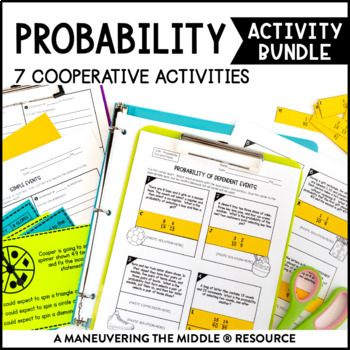Probability Activity Bundle | Experimental & Theoretical Probability Activities
- Zip
What educators are saying
Products in this Bundle (7)
showing 1-5 of 7 products
Description
This Probability Activity Bundle includes 7 classroom activities to determine simple probability, compare experimental and theoretical probability, make predictions, determine independent probability, and find dependent probability.
These hands-on and engaging activities are all easy to prep! Students are able to practice and apply concepts with these probability activities, while collaborating and having fun! Math can be fun and interactive!
Standards: CCSS (7.SP.5, 7.SP.6, 7.SP.7, 7.SP.8) and TEKS (7.6A, 7.6C, 7.6D, 7.6E, 7.6H, 7.6I)
More details on what is included:
Seven hands-on activities that can be utilized in pairs or groups of 3-4. All activities include any necessary recording sheets and answer keys.
- Mazes: simple probability
- Find It, Fix It: simple events
- Stations: experimental and theoretical probability
- Dominos: making predictions (long-run relative frequency)
- He Said, She Said: independent probability
- Cut and Paste: dependent probability
- Task Cards: probability unit review
***Please download a preview to see sample pages and more information.***
How to use this resource:
- Use as a whole group classroom activity
- Use in a small group for additional remediation, tutoring, or enrichment
- Use as an alternative homework or independent practice assignment
- Incorporate within our Probability Unit to support the mastery of concepts and skills.
Time to Complete:
- Most activities can be utilized within one class period. Performance tasks summarize the entire unit and may need 2-3 class periods. However, feel free to review the activities and select specific problems to meet your students’ needs and time specifications. There are multiple problems to practice the same concepts, so you can adjust as needed.
Looking for instructional materials?
- Check out the corresponding Probability Unit, which includes student handouts, independent practice, assessments, and answer keys.
More 7th Grade Activity Bundles:
Unit 1: Rational Number Operations
Unit 2: Expressions and Equations
Unit 4: Proportional Relationships
Unit 7: Plane Geometry and Similarity
More 7th Grade Units:
Unit 1: Rational Number Operations
Unit 2: Expressions and Equations
Unit 4: Proportional Relationships
Unit 7: Plane Geometry and Similarity
Looking for more helpful teaching tips, ideas, and support? Check out Maneuveringthemiddle.com and join our online FB community MTM VIPS!
Try out a FREE math resource! Grab your freebie here!
Licensing:
This file is a license for ONE teacher and their students. Please purchase the appropriate number of licenses if you plan to use this resource with your team. Thank you!
Customer Service:
If you have any questions, please feel free to reach out for assistance. We aim to provide quality resources to help teachers and students alike, so contact me before leaving feedback if you have a need.
Maneuvering the Middle® Terms of Use
Products by Maneuvering the Middle®, LLC may be used by the purchaser for their classroom use only. This is a single classroom license only. All rights reserved. Resources may only be posted online in an LMS such as Google Classroom, Canvas, or Schoology. Students should be the only ones able to access the resources. It is a copyright violation to upload the files to school/district servers or shared Google Drives. See more information on our terms of use here.
If you are interested in a personalized quote for campus and district licenses, please click here.
©Maneuvering the Middle® LLC, 2012-present





